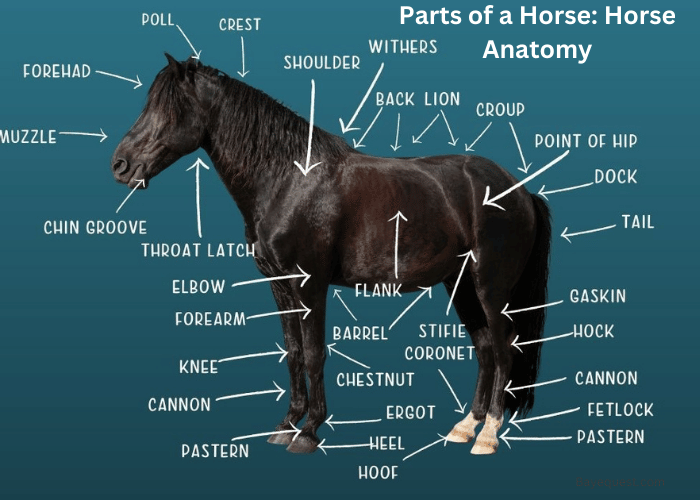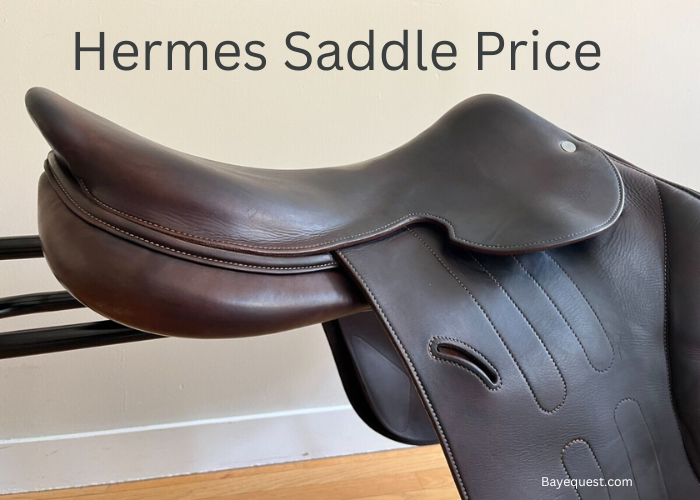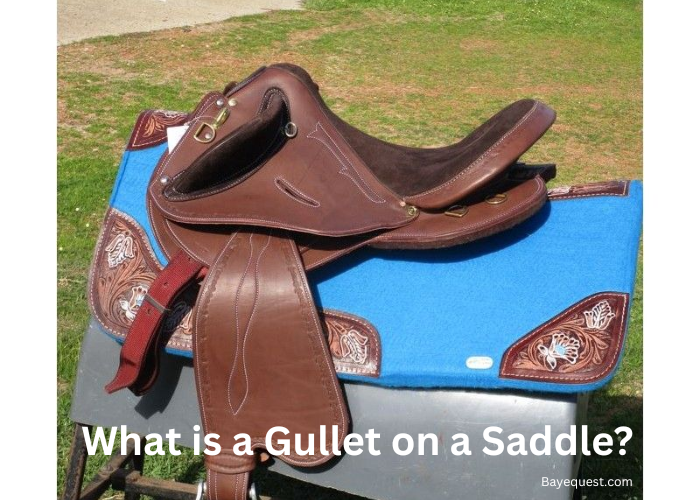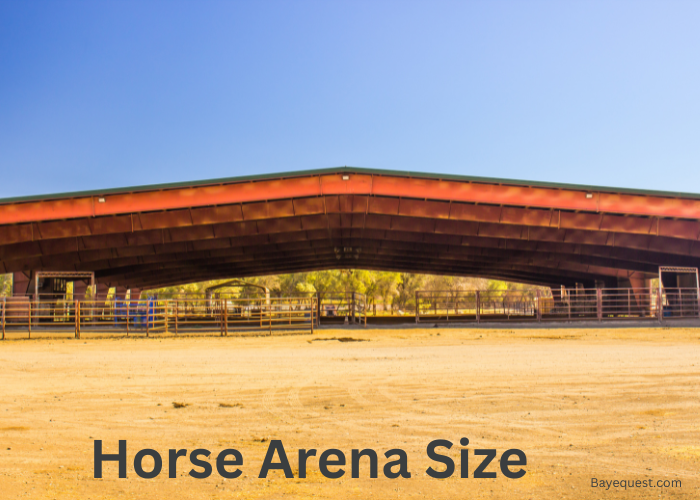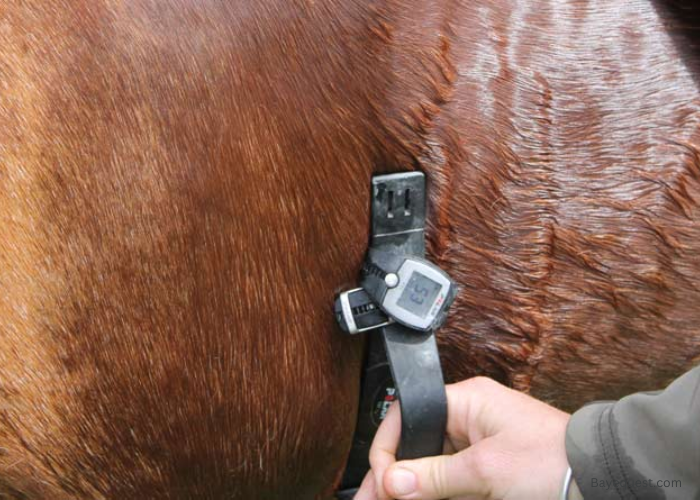A horse’s body is a masterpiece of strength and elegance. From the powerful legs that carry them across fields to the sensitive ears that catch every sound, every part has a purpose.
Understanding a horse’s anatomy isn’t just for experts—it helps anyone who loves or works with horses.
Knowing the names of these parts and how they function can make you a better rider, caretaker, or enthusiast.
This guide breaks it down simply, so you’ll know the key areas that keep a horse healthy, happy, and performing at its best.
Parts of a Horse: Horse Anatomy Diagram
Horse Head Anatomy
The horse’s head is crucial for many functions. It houses the brain, sensory organs, and teeth.
The head is made of bones, muscles, and nerves. It helps with feeding, seeing, hearing, and smelling. It also plays a role in communication and balance.
Some parts of the head include:
Occiput
The occiput is the back part of the horse’s skull. It connects the head to the neck.
This area is important for head movement. It allows the horse to look around and graze.
The occiput also supports the muscles that control neck movement.
Crown
The crown is the top part of the horse’s head. It’s located between the ears.
This area is often used to fit bridles and headgear. The crown helps with balance and supports the head’s weight.
Forehead
The forehead is the flat area between the eyes and ears. It protects the brain and plays a role in expressing emotions.
Horses can show alertness or relaxation through their forehead muscles.
Forelock
The forelock is the tuft of hair between the ears. It helps protect the horse’s eyes from insects.
The forelock also enhances the horse’s overall appearance. Show horses often have it braided or groomed.
Poll
The poll is the area right behind the ears, where the top of the head meets the neck.
It is a sensitive spot for horses, and proper handling is important for comfort. The poll also helps with head and neck movement.
Horse ears
Horse ears are vital for hearing and communication. They can rotate almost 180 degrees.
This allows horses to detect sounds from all directions. Ear positions can indicate a horse’s mood. Forward ears show interest, while pinned-back ears indicate annoyance.
Horse eyes
Horse eyes are large and positioned on the sides of the head. This gives them a wide field of vision.
Horses can see almost 360 degrees. They rely on their eyes to detect movement. Good vision is crucial for safety and navigation.
Horse teeth
Horse teeth are essential for chewing and grinding food. They have incisors for cutting and molars for grinding.
Dental health is crucial for overall well-being. Regular check-ups prevent problems like tooth decay and sharp edges.
Muzzle
The muzzle includes the nose and mouth area. It’s used for smelling and eating. Horses have a keen sense of smell.
The muzzle is also sensitive to touch. It’s often used to explore their environment.
Throat latch
The throat latch is the area under the jaw. It’s where the head connects to the neck, and it’s important for breathing and swallowing.
A flexible throat latch helps with head and neck movement, and properly fitted gear ensures comfort.
Read also: Why Do Horses Bob Their Heads?
Horse Neck Anatomy
The horse’s neck is a vital part of its anatomy. It connects the head to the body and supports many essential functions.
The neck contains muscles, vertebrae, and blood vessels. It helps with balance, movement, and flexibility. A well-muscled neck is important for strength and control.
Types of Horse Necks
Straight neck: A straight neck has a uniform, flat line from the poll to the withers. It provides good balance and is common in many breeds.
Arched neck: An arched neck curves gracefully. It is often seen in dressage and show horses. This type enhances appearance and flexibility.
Ewe neck: The neck of an ewe dips in the middle and rises at the base. It can affect balance and performance, and proper training can help improve its function.
Swan neck: A swan’s neck has a high curve, similar to a swan’s. It is elegant and desirable in certain breeds. It provides good balance and flexibility.
Crest
The crest is the upper part of the neck. It’s the area where the mane grows. A well-developed crest is a sign of a healthy horse.
It should be firm but not too thick. The crest helps with balance and strength. Overweight horses can develop a fatty crest, which can be unhealthy.
Mane
The mane is the long hair that grows from the crest. It protects the neck from insects and the elements.
The mane also adds to the horse’s appearance. Depending on the breed and grooming, it can be long, short, thick, or thin.
In some disciplines, the mane is braided or clipped. Proper care of the mane includes regular brushing and cleaning. This prevents tangles and keeps it healthy.
Horse Barrel, or the Trunk Anatomy
The barrel, or trunk, is the main body of the horse. It includes the ribcage and abdomen. The barrel is important for housing vital organs like the heart and lungs.
A deep, well-sprung barrel allows for good lung capacity and stamina. It looks round and full, indicating good health and feeding.
Let’s look at what the barrel hosts:
Horse withers
The withers are the highest point of the back, just above the shoulders. They are bony and prominent.
The withers are crucial for fitting saddles. They also help in measuring the height of a horse. Strong withers provide stability for the rider.
Back/Spine
The back, or spine, runs from the withers to the loin. It supports the rider and distributes weight.
A straight, strong back is ideal for performance. The spine should be free of dips or excessive curvature. Proper muscle development is key to a healthy back.
Loin
The loin is the area between the back and the croup. It is short and muscular.
The loin helps with power and flexibility. It connects the strong hindquarters to the back.
A strong loin is crucial for jumping and quick movements.
Croup
The croup is the top part of the hindquarters, right behind the loin. It is slightly sloped and muscular.
The croup plays a role in propulsion and power. It should be well-rounded and smooth. This area contributes to a horse’s speed and agility.
Hip point
The hip point is the bony protrusion on each side of the croup. It is part of the pelvis.
The hip point helps in defining the shape of the hindquarters. It plays a role in movement and strength. Visible but not overly pronounced hip points are ideal.
Dock
The dock is the solid part at the top of the tail. It is the base from which the tail hair grows. The dock helps in communication and balance.
It should be flexible but firm. A well-groomed dock indicates good health and care.
Tail
The tail consists of the dock and the long hairs that grow from it. It is used for swatting flies and expressing emotions.
The tail helps with balance and communication. It can be long, short, thick, or thin. Regular grooming keeps the tail healthy and free of tangles.
Related read: Do Horses Have Tails or Is It Just Hair?
Chest
The chest is the front part of the horse’s body between the forelegs. It houses the heart and lungs.
A wide, deep chest indicates good lung capacity and strength. It should be well-muscled and firm. A strong chest is important for endurance and performance.
Barrel
The barrel, as mentioned, is the main body of the horse. It includes the ribcage and abdomen. A well-rounded barrel indicates good health.
It allows space for the heart and lungs to function properly. Proper nutrition and care are essential for a healthy barrel.
Flank
The flank is the area between the ribs and the hind legs. It is where the abdomen meets the hindquarters.
The flank should be smooth and slightly sunken. It helps in flexibility and movement. Proper care of the flank area ensures overall health.
Girth
The girth is the area behind the front legs, around the horse’s body. It is where the saddle girth or cinch is placed.
The girth helps in securing the saddle. It should be firm and well-muscled. Proper fitting of the girth is crucial for comfort and performance.
Front and Back Limbs Anatomy
The limbs of a horse are vital for movement and support. The front limbs bear more weight, while the back limbs provide power and propulsion.
Each limb is made up of bones, joints, and muscles that work together for smooth movement. Let’s get into the anatomy of a horse’s legs.
Shoulder
The shoulder is located between the neck and the upper arm. It is sloped and muscular.
The shoulder’s angle affects the horse’s stride and reach. A well-angled shoulder allows for better movement and comfort.
Upper arm
The upper arm is the section between the shoulder and the elbow. It is short and strong.
The upper arm helps with the forward movement of the front legs. Strong upper arm muscles contribute to the horse’s overall power.
Elbow
The elbow is the joint where the upper arm meets the forearm. It allows for bending and straightening of the front legs.
A properly aligned elbow is crucial for smooth and efficient movement. It should be free of swelling or stiffness.
Forearm
The forearm extends from the elbow to the knee. It is long and muscular.
The forearm provides strength and support for the front legs. Well-developed forearm muscles contribute to speed and endurance.
Carpus (Knee)
The carpus, or knee, is the forearm and cannon bone joint. It is similar to a human wrist.
The knee is essential for shock absorption and flexibility. A well-formed knee supports smooth movement and reduces injury risk.
Hindquarters
The hindquarters are the back part of the horse’s body. They include the hips, thighs, and croup.
The hindquarters are powerful and muscular. They provide propulsion and strength for running, jumping, and other movements.
Stifle
The stifle is the joint where the thigh meets the gaskin. It is similar to a human knee.
The stifle allows for bending and straightening of the hind leg. A healthy stifle is crucial for flexibility and movement. It should be free of swelling and pain.
Read also: Stifle Injury in Horses.
Gaskin
The gaskin is the area between the stifle and the hock. It is muscular and strong. The gaskin provides power and propulsion for the hind legs.
Well-developed gaskin muscles contribute to the horse’s speed and agility.
Hock
The hock is the joint between the gaskin and the cannon bone in the hind leg. It is similar to a human ankle.
The hock allows for bending and provides leverage for movement. A well-formed hock supports balance and power.
Ergot
The ergot is a small, callous-like growth found on the back of the fetlock. It is usually hidden by hair.
The ergot is thought to be a vestigial structure. It does not have a significant role in modern horses but can be an indicator of the horse’s ancestry.
Cannon bone and splint bone
The cannon bone is the large, weight-bearing bone in the lower leg. It is strong and straight.
The splint bone runs alongside the cannon bone. It is smaller and helps support the leg. Together, they provide stability and support for the leg.
Chestnut
The chestnut is a small, callous-like growth found on the inside of each leg. It is thought to be a vestigial structure.
Chestnuts are unique to each horse, like fingerprints. They do not have a significant role but can be used for identification.
Pastern
The pastern is the area between the fetlock and the hoof. It is made up of two bones. The pastern provides shock absorption and flexibility.
A well-angled pastern contributes to smooth movement and reduces injury risk.
Fetlock
The fetlock is the joint between the cannon bone and the pastern. It is similar to a human knuckle.
The fetlock allows for bending and provides flexibility. A healthy fetlock is crucial for shock absorption and smooth movement.
Horse Hoof Anatomy
The hoof is the hard, outer part of a horse’s foot. It protects the inner structures and supports the horse’s weight.
The hoof is made of keratin, similar to human nails. A healthy hoof is essential for movement and balance.
Regular trimming and care are vital to prevent issues like cracks and infections. (Read also: How Wild Horses Trim Their Hooves)
Hoof parts include:
Coronet band
The coronet band is the area where the hoof meets the skin of the leg. It is a narrow, soft band at the top of the hoof.
The coronet band is crucial for hoof growth. Any injury to this area can affect the hoof’s health and growth. Proper care includes keeping it clean and free of injuries.
Heel
The heel is the back part of the hoof. It is softer and more flexible than the rest of the hoof.
The heel helps with shock absorption and provides traction. Healthy heels are essential for balance and movement.
Proper trimming helps maintain heel health and prevents overgrowth.
Frog
The frog is the V-shaped, rubbery structure on the underside of the hoof. It helps with shock absorption and provides traction.
The frog also aids circulation by pumping blood back up the leg with each step. Keeping the frog clean and free of debris is essential for hoof health.
Toe
The toe is the front part of the hoof. It is the point that makes initial contact with the ground during movement.
The toe plays a role in balance and direction. Proper toe trimming is crucial to maintain the correct hoof shape and prevent lameness.
Internal Anatomy of a Horse
Discover the vital internal systems of horses: muscular, skeletal, respiratory, digestive, and circulatory.
Horse muscular system anatomy
The muscular system in horses is vital for movement and posture. It consists of over 700 muscles. These muscles are categorized into three types:
Skeletal muscles. These are attached to bones and control voluntary movements like walking, running, and jumping. They work in pairs to contract and relax, enabling precise movements.
Smooth muscles. These muscles are found in internal organs such as the stomach and intestines. They control involuntary actions like digestion and blood vessel constriction.
Cardiac muscle. This specialized muscle makes up the heart. It contracts rhythmically and involuntarily to pump blood throughout the body.
Healthy muscles are crucial for a horse’s performance, strength, and endurance. Proper nutrition, exercise, and care are essential for maintaining muscle health.
Equine skeletal system anatomy
The skeletal system provides the framework for the horse’s body. It consists of around 205 bones, including:
Skull. Protects the brain and supports the facial structure.
Spine. Composed of vertebrae, it supports the body and protects the spinal cord.
Ribs. Protect the heart and lungs.
Limbs. Consists of bones like the femur, tibia, radius, and cannon bone, providing support and facilitating movement.
Joints. made up of cartilage and ligaments, connect the bones and allow for flexibility and movement. The skeletal system also stores minerals and produces blood cells in the bone marrow.
Horse respiratory system anatomy
The respiratory system is responsible for oxygen intake and carbon dioxide expulsion. It includes:
Nostrils and nasal passages. Filter and warm the air entering the body.
Larynx and trachea. Conduct air to the lungs.
Lungs. Main organs of respiration where gas exchange occurs. (Read our other guide to know the size of horses’ lungs and other interesting facts.)
Diaphragm. A muscle that contracts and relaxes to enable breathing.
Air travels from the nostrils through the trachea to the lungs, exchanging oxygen for carbon dioxide in the alveoli.
Efficient respiration is crucial for energy production and overall health, especially in performance horses.
Horse digestive system anatomy
The digestive system processes food, absorbs nutrients, and eliminates waste. Key components include:
Mouth and teeth. Chew food and mix it with saliva.
Esophagus. Transports food to the stomach.
Stomach. Begins the breakdown of food with acids and enzymes.
Small intestine. Major site for nutrient absorption.
Cecum. A fermentation chamber where microbes break down fibrous plant material.
Large intestine. Absorbs water and forms waste.
Horses have a unique digestive system adapted for continuous grazing. Proper feeding practices are essential to prevent issues like colic and laminitis.
Horse circulatory system anatomy
The circulatory system transports blood, nutrients, oxygen, and waste products throughout the body. It includes:
Heart. A four-chambered organ that pumps blood.
Arteries. Carry oxygen-rich blood away from the heart.
Veins. Return oxygen-depleted blood to the heart.
Capillaries. Small vessels where nutrient and gas exchange occurs.
The heart pumps oxygenated blood from the lungs to the body and returns deoxygenated blood to the lungs for oxygenation.
A healthy circulatory system is essential for maintaining energy levels, healing, and overall health. Proper conditioning and cardiovascular exercise improve.
Find out more about how the circulatory system works in this article.
Why is it Important to Know the Parts of a Horse’s Body?
Knowing the anatomy of your horse is crucial for several reasons:
Health monitoring. Understanding anatomy helps you identify early signs of illness or injury.
Proper care. Knowledge of anatomy aids in providing appropriate grooming, feeding, and overall care.
Effective training. Understanding your horse’s physical capabilities and limitations allows for better training programs.
Better communication. Knowing anatomy helps you interpret your horse’s body language and behavior. This fosters a stronger bond and improves communication.
Saddle and tack fit. Properly fitting equipment prevents discomfort and injuries, ensuring your horse’s comfort and performance.
Emergencies. In emergencies, understanding anatomy allows for quick and effective first aid.
Horse Skin and its Products
The horse’s skin is the largest organ of their body. It protects against external elements, regulates temperature, and allows sensation.
The products from horse skin include:
Leather. Horsehide is used to make high-quality leather for saddles, bridles, boots, and other riding gear. It’s durable and strong.
Gelatin. Derived from horse hooves and bones, used in food and pharmaceuticals.
Glue. Made from collagen found in horse hides, hooves, and bones, used for various adhesive products.
Hair. Tail hair is used for making violin bows, jewelry, and brushes.
Parts of a Horse: Horse Anatomy: Conclusion
Understanding horse anatomy is key to being a good horse owner. It helps you take better care of your horse.
You can spot health issues early. You can ensure proper training and fitting of gear. This knowledge also strengthens your bond with your horse.
You improve their well-being by knowing each part, from the head to the hooves. Remember, a healthy horse is a happy horse.
Keep learning and observing. Your horse will thank you for it.




